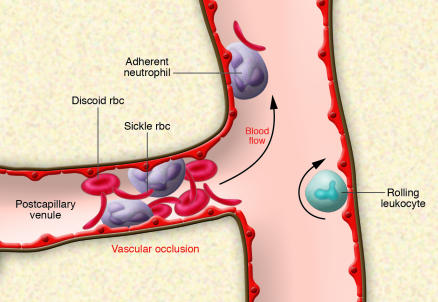Figure 4. Sickle cell vasoocclusion.
Abnormal, sickle rbc induce the expression of inflammatory and coagulation mediators, leading to the activation of the vascular endothelium. Sickle rbc themselves may also stimulate endothelial cells directly by adhesion. The stimulated endothelial cells are poised to recruit rolling and adherent leukocytes in venules by expressing chemokines and cell adhesion molecules such as the selectins and immunoglobulin family members. Activated, firmly adherent neutrophils capture circulating discoid and sickle-shaped rbc, leading to transient episodes of vascular occlusions that are initiated in the smallest postcapillary venules. Interactions between rbc and leukocytes tend to occur at vessel junctions, where leukocyte recruitment is the most active. In sickle mice, vasoocclusion can be prevented by the inhibition of leukocyte adhesion or the inflammatory response. The large arrow indicates the direction of blood flow.

